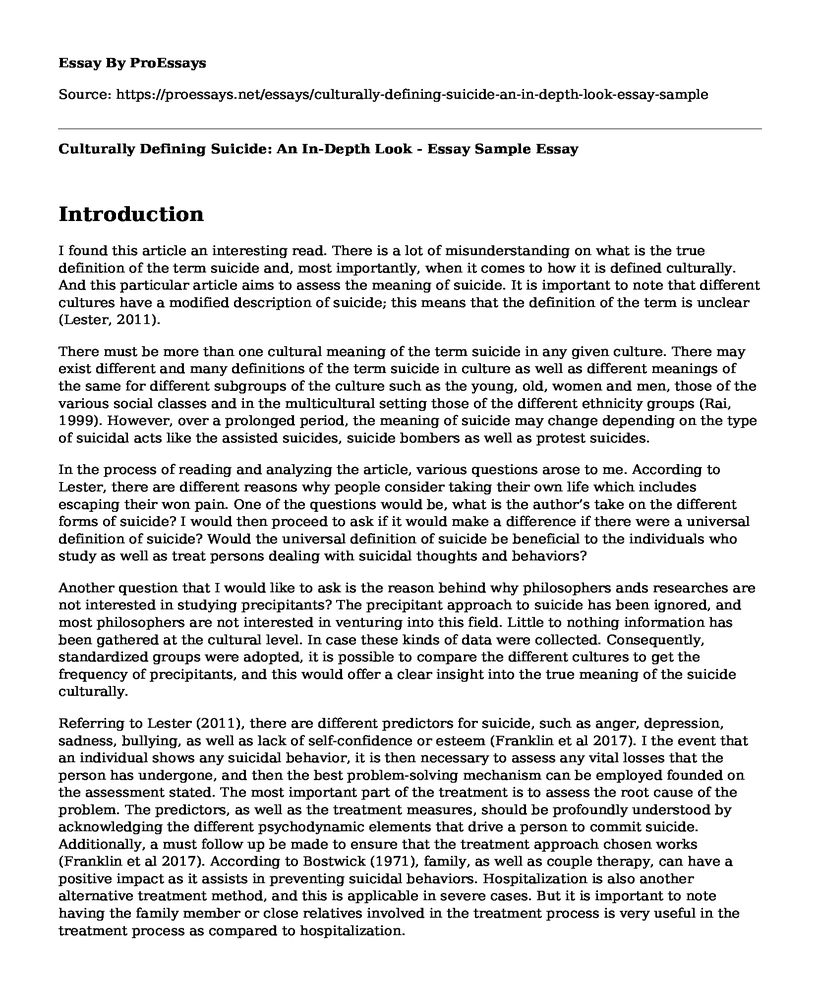Introduction
I found this article an interesting read. There is a lot of misunderstanding on what is the true definition of the term suicide and, most importantly, when it comes to how it is defined culturally. And this particular article aims to assess the meaning of suicide. It is important to note that different cultures have a modified description of suicide; this means that the definition of the term is unclear (Lester, 2011).
There must be more than one cultural meaning of the term suicide in any given culture. There may exist different and many definitions of the term suicide in culture as well as different meanings of the same for different subgroups of the culture such as the young, old, women and men, those of the various social classes and in the multicultural setting those of the different ethnicity groups (Rai, 1999). However, over a prolonged period, the meaning of suicide may change depending on the type of suicidal acts like the assisted suicides, suicide bombers as well as protest suicides.
In the process of reading and analyzing the article, various questions arose to me. According to Lester, there are different reasons why people consider taking their own life which includes escaping their won pain. One of the questions would be, what is the author’s take on the different forms of suicide? I would then proceed to ask if it would make a difference if there were a universal definition of suicide? Would the universal definition of suicide be beneficial to the individuals who study as well as treat persons dealing with suicidal thoughts and behaviors?
Another question that I would like to ask is the reason behind why philosophers ands researches are not interested in studying precipitants? The precipitant approach to suicide has been ignored, and most philosophers are not interested in venturing into this field. Little to nothing information has been gathered at the cultural level. In case these kinds of data were collected. Consequently, standardized groups were adopted, it is possible to compare the different cultures to get the frequency of precipitants, and this would offer a clear insight into the true meaning of the suicide culturally.
Referring to Lester (2011), there are different predictors for suicide, such as anger, depression, sadness, bullying, as well as lack of self-confidence or esteem (Franklin et al 2017). I the event that an individual shows any suicidal behavior, it is then necessary to assess any vital losses that the person has undergone, and then the best problem-solving mechanism can be employed founded on the assessment stated. The most important part of the treatment is to assess the root cause of the problem. The predictors, as well as the treatment measures, should be profoundly understood by acknowledging the different psychodynamic elements that drive a person to commit suicide. Additionally, a must follow up be made to ensure that the treatment approach chosen works (Franklin et al 2017). According to Bostwick (1971), family, as well as couple therapy, can have a positive impact as it assists in preventing suicidal behaviors. Hospitalization is also another alternative treatment method, and this is applicable in severe cases. But it is important to note having the family member or close relatives involved in the treatment process is very useful in the treatment process as compared to hospitalization.
Suicide can, therefore, be described as the act of taking one’s life for reasons that might never be uncovered. Suicide is an international menace, and there are different reasons why a person may decide to commit suicide, including; stress and depression, bullying, mental disorder, and undergoing traumatic events, just to name a few.
Conclusion
In conclusion, the article was interesting and a good read. It is impressive on how different cultures perceive suicide, and it is useful in offering diverse information on the factors leading to suicide and the way it impacts persons. It also provides insight on the predictors, prevention as well as treatment methods which show a lot of promise.
References
Bostwick, J. M. (1971). Treatment of Suicidal Patients. Psychiatry, 119, 629-33. https://psychiatryonline.org/pb/assets/raw/sitewide/practice_guidelines/guidelines/suicide.pdf
Franklin, J. C., Ribeiro, J. D., Fox, K. R., Bentley, K. H., Kleiman, E. M., Huang, X., & ... Nock, M. K. (2017). Risk factors for suicidal thoughts and behaviors: A meta-analysis of 50 years of research. Psychological Bulletin, 143(2), 187-232. doi:10.1037/bul0000084
Lester, D. (2011). The Cultural Meaning of Suicide: What Does That Mean? Omega: Journal of Death & Dying, 64(1), 83-94. doi: 10.2190/OM.64.1.f
Rai, M. F. (1999, May 24). Evaluation and Treatment of Patients with Suicidal Ideation. Retrieved March 05, 2017, from http://www.aafp.org/afp/1999/0315/p1500.html
Cite this page
Culturally Defining Suicide: An In-Depth Look - Essay Sample. (2023, Aug 13). Retrieved from https://proessays.net/essays/culturally-defining-suicide-an-in-depth-look-essay-sample
If you are the original author of this essay and no longer wish to have it published on the ProEssays website, please click below to request its removal:
- Cultural Relevance of Mental Health Patient Navigators for Ethnic Minority Groups
- Essay Sample - Love is Equal to Cholera as Written by Gabriel Garcia Marquez
- The Suicide Epidemic in Japan Annotated Bibliography
- Interview to Nurture the Potential of the Aging Interviewee Paper Example
- Essay Sample on Conceptualization Paradigms for Mental Disorders
- Essay Example on My Leadership Skills: Growing & Developing Annually
- Essay Sample on Components of the Memory System: An In-Depth Analysis







